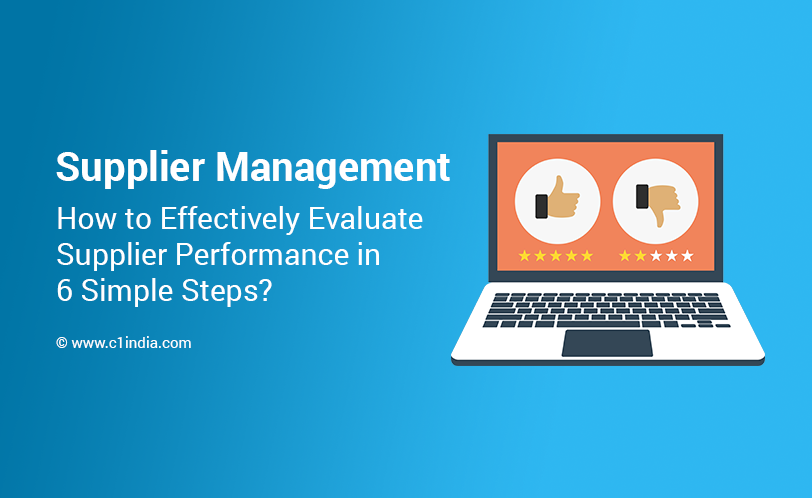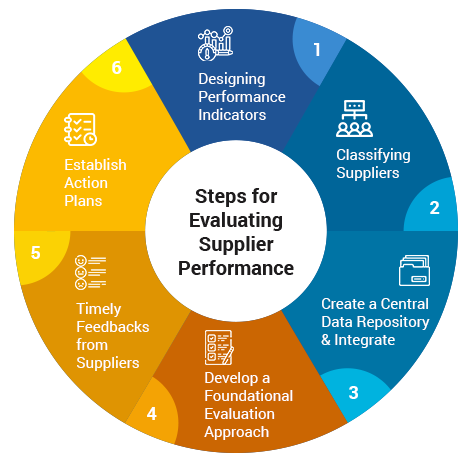How to Effectively Evaluate Supplier Performance in 6 Simple Steps?
By Sanjay Puri, CEO, C1 India

In our last blog, we explored what exactly is supplier management, its benefits, and the process. We often touched upon evaluating supplier performance in our previous blog, so without further ado let’s understand the entire evaluation process in depth.
Management of the supplier base is deemed to be tricky especially for businesses with a global presence and it’s a challenging task due to various business rules differing from one geographical area to another. It is crucial to have an evaluation plan, predefined accountability, and reasonable output to continue building long-term business relationships. A systematic evaluation plan is mandatory to improve strategic decision making which ultimately helps in repeat purchases, identifying and selecting the best supplier/s, replacing low performing suppliers, and improving cost-savings.
It is critical to evaluate for preventing product issues, improving deliverables, payments, and predominantly to drive improvements in the value chain. The supplier performance evaluation assists in deriving and leveraging actionable insights to gauge maverick expenditure, operational efficiency, and overall business performance with a scope of further improvements.
Let's explore a standard methodology for evaluating supplier performance-

- Designing performance indicators – The first and foremost step is to create an actionable supplier evaluation plan consisting of various underlying parameters and KPIs. These parameters build the base of an action plan, hence requires the utmost focus and detailed planning. Without proper establishment of performance indicators, a business can massively suffer during a crisis or would be prone to taking wrong decisions based on faulty/incorrect insights. So the certain focal points where a business should critically examine and broadly define, are - price, cost, quantity, quality, service, delivery, payment terms and structure, certifications (for greater trust and validation), innovation, financial aspects/heath, and compliance. Having a detailed overview of these parameters helps businesses to sail smoothly, improve operational efficiency, reduce costs, increase profit margins, enhance growth prospects, bring ease in management, improve negotiations, and derive actionable insights. These underlying KPIs help to assess and compare the actual and planned performance.
- Classifying Suppliers – The next important step is to homogenously categorize suppliers depending upon the factors such as geography, product types, large scale, small scale, etc.
- Create a central data repository and integrate – It is important to have a centralized portal for storing supplier information and having a database of each supplier. This helps in accessing any information regarding suppliers easily and quickly.
- Develop a foundational evaluation approach – post creating a central data repository, a solid evaluation method is required to be designed. Some examples are supplier scorecards, six sigma, contract management, etc.
- Timely feedbacks for review from suppliers – Since all the assessments can’t be quantifiable, so a timely feedback system helps in identifying improvement scope, or any bottlenecks. Regular feedbacks help in improving existing supplier relationships and leads to higher customer satisfaction.
- Establish action plans – Finally, the last step is to create a feasible and actionable plan with guidelines for handling a specific type of supplier relationship. Timely analysis and comparison of current and planned performance are essential for maintaining quality standards. It helps in highlighting performance gaps and helps in strategically devising corrective measures. To successfully evaluate supplier performance, people, processes, and technology need to combine as one. The collective output, followed as per a well-designed plan, works wonder for business.
Evaluation and establishing a framework for analysis is extremely important for managing suppliers and supplier relationships. The evaluation benefits are beyond managing as it helps in strategically handling situations, minimizing risks during any crisis, redeeming cost benefits, resulting in favourable negotiated deals, and ultimately improving transparency. So evaluation is a critical component of supplier management and every business should have a defined framework to succeed and improve growth prospects.
Stay tuned for our next blog to learn about supplier risk management.
